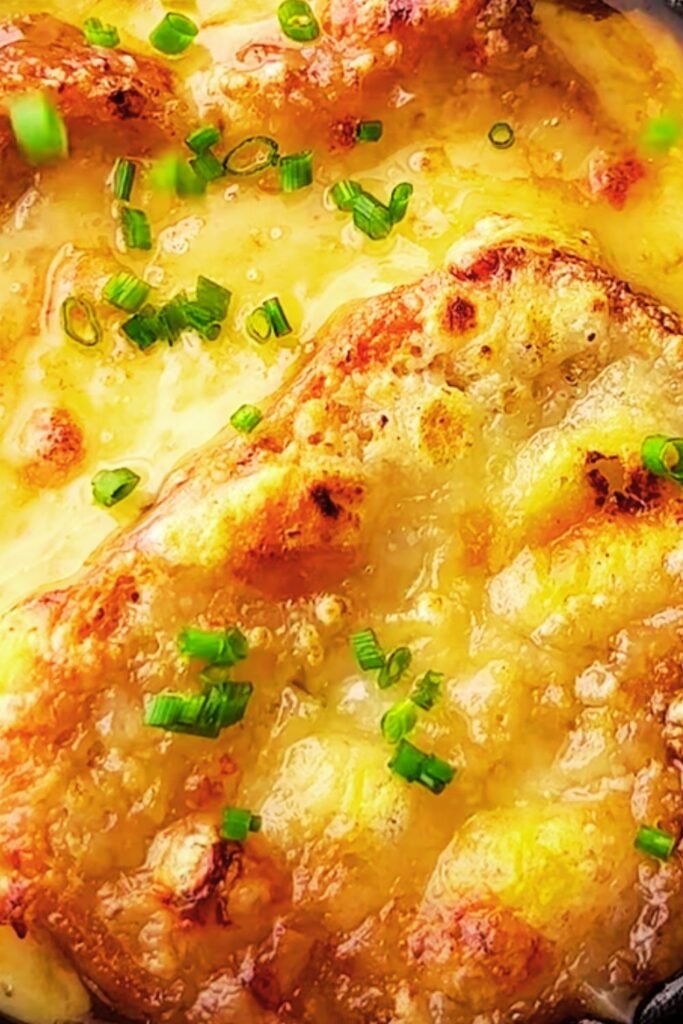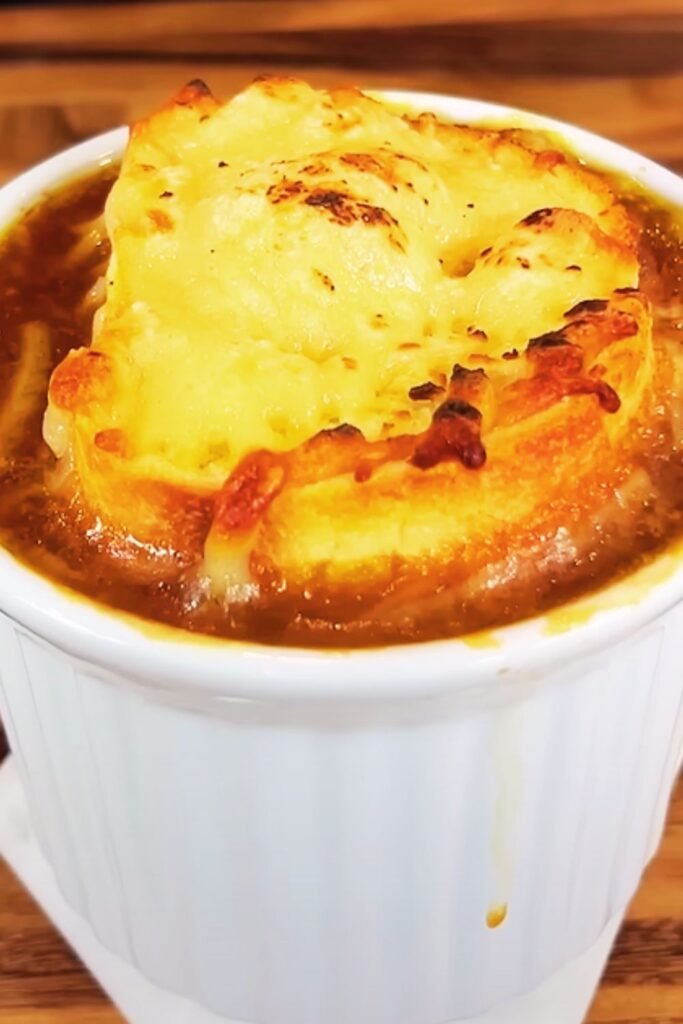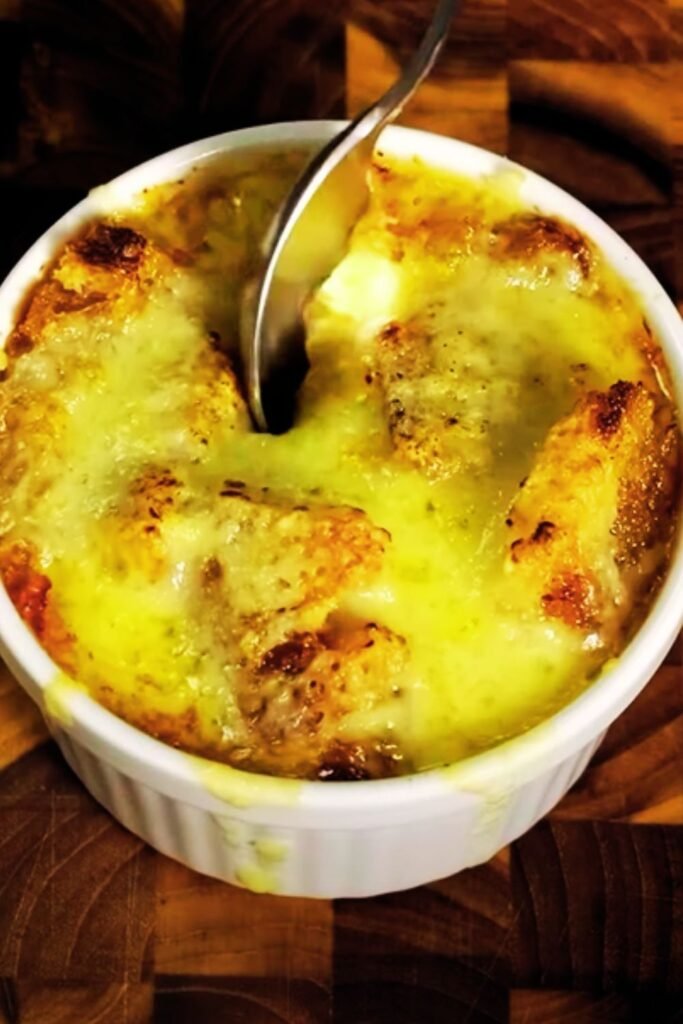There’s something magical about the aroma of caramelized onions filling my kitchen on a cold evening. French Onion Soup has been my go-to comfort food for years, and I’ve perfected this recipe through countless bowls shared with family and friends. What started as an intimidating restaurant dish has become one of my most requested recipes, and I’m thrilled to share every secret I’ve learned along the way.
This isn’t just another soup recipe – it’s a journey into one of France’s most beloved culinary traditions, simplified for the modern home cook. My version delivers all the rich, complex flavors you’d expect from a Parisian bistro, but with techniques that won’t keep you chained to the stove for hours.
The Soul of French Onion Soup
French Onion Soup represents everything I love about classic cooking: simple ingredients transformed into something extraordinary through patience and technique. The dish originated in 18th century France, where resourceful cooks discovered that slowly caramelizing humble onions could create a base for the most satisfying of soups.
Key Components:
- Caramelized Onions: The foundation that provides deep, sweet flavor
- Rich Broth: Traditionally beef-based, creating the soup’s savory backbone
- Gruyère Cheese: The crowning glory that melts into golden perfection
- French Bread: Provides texture and soaks up the delicious broth
The beauty of this soup lies in its transformation. Raw onions become golden and sweet, simple broth develops complexity, and cheese creates that iconic bubbling top that makes my mouth water every time.
Essential Ingredients Breakdown
| Ingredient | Amount | Purpose | Substitution Options |
|---|---|---|---|
| Yellow Onions | 6 large (3 lbs) | Primary flavor base | Sweet onions, white onions |
| Butter | 4 tablespoons | Fat for caramelization | Olive oil, combination of both |
| Beef Broth | 8 cups | Soup foundation | Vegetable broth, chicken broth |
| Dry White Wine | 1/2 cup | Deglazing, adds depth | Additional broth, dry sherry |
| Fresh Thyme | 2 teaspoons | Aromatic herb | Dried thyme (1 tsp) |
| Bay Leaves | 2 whole | Background flavor | Skip if unavailable |
| Gruyère Cheese | 2 cups grated | Topping | Swiss, Provolone |
| French Bread | 6 slices | Texture, absorption | Any crusty bread |
| Salt & Pepper | To taste | Seasoning | – |
My secret ingredient? A splash of balsamic vinegar added during caramelization. It enhances the onions’ natural sweetness and adds a subtle complexity that guests can never quite identify.
Equipment You’ll Need
Having the right tools makes this recipe significantly easier and more enjoyable to prepare.
Essential Equipment:
- Heavy-bottomed pot or Dutch oven (at least 6-quart capacity)
- Wooden spoon for stirring
- Sharp chef’s knife
- Cutting board
- Oven-safe bowls or crocks
- Box grater for cheese
- Ladle for serving
Optional but Helpful:
- Mandoline slicer for uniform onion slices
- Immersion blender for smoother texture (if desired)
- Kitchen timer to track caramelization stages
The heavy-bottomed pot is crucial – it prevents hot spots that can burn your onions during the long caramelization process. I learned this lesson the hard way after ruining several batches in thin-bottomed pans.
Step-by-Step Cooking Process
Phase 1: Onion Preparation
The foundation of exceptional French Onion Soup begins with proper onion preparation. I slice my onions from pole to pole, creating half-moons that hold their shape better during cooking.
- Slice the onions: Cut each onion in half through the root end, then slice into 1/4-inch thick half-moons
- Heat the pot: Warm your heavy-bottomed pot over medium heat
- Add fat: Melt butter (or heat oil) until it shimmers but doesn’t smoke
- Add onions: Include all onions at once – they’ll seem overwhelming but will cook down significantly
Phase 2: The Caramelization Journey
This is where patience becomes your greatest ally. True caramelization takes time, but the results are worth every minute.

Timeline and Visual Cues:
- 0-10 minutes: Onions soften and release moisture
- 10-20 minutes: Volume reduces by half, onions become translucent
- 20-35 minutes: Golden color develops, stirring becomes more important
- 35-45 minutes: Deep amber color, sweet aroma intensifies
- 45-60 minutes: Rich brown color, jammy consistency achieved
The key is maintaining medium to medium-low heat. If onions start browning too quickly, reduce heat immediately. I stir every 5-7 minutes initially, then more frequently as caramelization progresses.
Phase 3: Building the Soup Base
Once your onions reach that perfect caramelized state, it’s time to build the soup’s flavor foundation.
- Deglaze: Add wine, scraping up any browned bits from the pot bottom
- Add aromatics: Include thyme and bay leaves for fragrance
- Pour in broth: Add warm broth gradually, allowing flavors to meld
- Season carefully: Start with less salt – you can always add more later
- Simmer: Allow 20-30 minutes for flavors to marry completely
The deglazing step is crucial – those browned bits contain concentrated flavor that elevates the entire soup.
Cheese and Bread Preparation
The final presentation of French Onion Soup is just as important as the soup itself. The contrast between the bubbling cheese and the rich broth creates the dish’s signature appeal.
Bread Selection and Preparation
I prefer day-old French bread or baguette slices, about 3/4-inch thick. Fresh bread can become soggy, while day-old bread maintains better texture.
Preparation Steps:
- Toast bread slices until golden but not crispy
- Rub with garlic clove for subtle flavor enhancement
- Cut to fit your serving bowls appropriately
Cheese Considerations
| Cheese Type | Melting Properties | Flavor Profile | Best Use |
|---|---|---|---|
| Gruyère | Excellent melting, no grease separation | Nutty, complex, slightly sweet | Traditional choice |
| Swiss | Good melting | Mild, nutty | Budget-friendly alternative |
| Provolone | Melts well | Sharp, tangy | Modern variation |
| Combination | Best of both | Complex layers | My personal preference |
I typically use 75% Gruyère and 25% sharp Provolone for complexity without overwhelming the soup’s delicate balance.
Assembly and Final Cooking

The final assembly requires attention to detail and proper technique to achieve that restaurant-quality presentation.
Assembly Process:
- Preheat broiler: Set to high heat while soup finishes simmering
- Ladle soup: Fill oven-safe bowls, leaving room for bread and cheese
- Float bread: Place toasted slice on soup surface
- Add cheese: Generously cover bread and soup edges
- Broil: 2-3 minutes until cheese bubbles and browns slightly
- Rest briefly: Allow 1-2 minutes for cheese to set before serving
The broiling step transforms good soup into spectacular soup. Watch carefully – cheese can go from perfectly golden to burnt in seconds.
Nutritional Information and Variations
Understanding the nutritional aspects helps you make informed decisions about this indulgent comfort food.
Nutritional Breakdown (Per Serving)
| Component | Amount | % Daily Value |
|---|---|---|
| Calories | 385 | 19% |
| Total Fat | 18g | 23% |
| Saturated Fat | 11g | 55% |
| Cholesterol | 45mg | 15% |
| Sodium | 1,240mg | 54% |
| Total Carbs | 35g | 13% |
| Dietary Fiber | 4g | 14% |
| Protein | 18g | 36% |
| Calcium | 420mg | 32% |
Based on 6 servings using traditional ingredients
Healthier Variations I’ve Developed
Lower-Sodium Version:
- Use low-sodium broth
- Reduce cheese by 25%
- Add fresh herbs for flavor enhancement
Lighter Option:
- Substitute olive oil for half the butter
- Use part-skim cheese varieties
- Serve with smaller bread portions
Vegetarian Adaptation:
- Replace beef broth with rich mushroom broth
- Add soy sauce for umami depth
- Include caramelized mushrooms alongside onions
Troubleshooting Common Issues
Through years of making this soup, I’ve encountered nearly every possible challenge. Here are solutions to the most common problems:
Problem: Onions burning during caramelization Solution: Lower heat immediately, add splash of broth to deglaze, continue more slowly
Problem: Soup tastes bland Solution: Season gradually, add splash of wine or vinegar, ensure proper browning occurred
Problem: Cheese doesn’t melt properly Solution: Grate cheese freshly, ensure soup is hot, check broiler positioning
Problem: Bread becomes soggy Solution: Toast bread more thoroughly, float rather than submerge, serve immediately
Problem: Too salty Solution: Add acid (lemon juice), dilute with additional broth, balance with sweet element
Storage and Reheating Guidelines
Proper storage ensures you can enjoy this soup for days after cooking, though I find it rarely lasts that long in my household.
Refrigeration:
- Store soup base without bread and cheese up to 4 days
- Keep in airtight containers to prevent flavor absorption
- Cool completely before refrigerating
Freezing:
- Soup base freezes well up to 3 months
- Freeze in portion-sized containers for convenience
- Never freeze assembled soup with bread and cheese
Reheating:
- Warm soup base gently on stovetop
- Add fresh bread and cheese for serving
- Microwave individual portions if necessary, though stovetop yields better results
Serving Suggestions and Pairings

French Onion Soup shines as both an elegant starter and a satisfying main course. I’ve served it successfully in various contexts, from casual family dinners to formal entertaining.
As an Appetizer:
- Serve in smaller bowls or ramekins
- Pair with light salads featuring mixed greens
- Follow with grilled proteins or lighter pasta dishes
As a Main Course:
- Serve generous portions with crusty bread on the side
- Accompany with simple green salads dressed with vinaigrette
- Add roasted vegetables for a complete meal
Complementary Sides:
- Mixed green salad with Dijon vinaigrette
- Roasted root vegetables
- Simple steamed broccoli or green beans
- Warm dinner rolls or garlic bread
Beverage Pairings:
- Sparkling water with lemon
- Rich coffee or espresso
- Herbal teas like chamomile or peppermint
- Fresh fruit juices
Seasonal Adaptations
I’ve learned to adapt this recipe throughout the year, taking advantage of seasonal ingredients and adjusting for weather conditions.
Fall Adaptations:
- Add roasted garlic for deeper flavor
- Include fresh sage alongside thyme
- Serve with apple slices for palate cleansing
Winter Modifications:
- Increase herb quantities for warming effect
- Add splash of brandy for richness
- Serve piping hot with extra cheese
Spring Variations:
- Lighten with additional fresh herbs
- Reduce portion sizes for warming weather
- Include fresh chives as garnish
Summer Adjustments:
- Serve slightly cooler temperature
- Reduce cheese quantities
- Pair with lighter, fresher sides
Cultural Significance and Personal Memories
French Onion Soup holds special meaning beyond its delicious taste. It represents the French culinary philosophy of transforming simple ingredients into something magnificent through technique and patience.
My relationship with this soup began during a college trip to Paris, where I first tasted authentic French Onion Soup at a small bistro near the Louvre. The combination of sweet onions, rich broth, and bubbling cheese created an unforgettable moment that inspired me to recreate this magic in my own kitchen.
Over the years, this soup has become my signature dish for cold weather entertaining. I’ve served it at dinner parties, brought it to potlucks, and made it countless times for family gatherings. Each bowl carries memories of shared conversations, warm kitchens, and the simple pleasure of nourishing the people I care about.
The meditative process of caramelizing onions has become almost therapeutic for me. There’s something deeply satisfying about the slow transformation, the gradual deepening of color and flavor that can’t be rushed or replicated through shortcuts.
Questions and Answers
Q: Can I make French Onion Soup ahead of time? A: Absolutely! I prepare the soup base up to 3 days ahead and store it refrigerated. When ready to serve, I reheat the base, ladle into bowls, add fresh bread and cheese, then broil. This actually improves the flavors as they have time to meld.
Q: What’s the secret to perfectly caramelized onions? A: Patience and consistent heat are key. I maintain medium to medium-low heat and resist the urge to rush. Properly caramelized onions should be deep brown and jammy, which typically takes 45-60 minutes. Stirring too frequently can actually slow the process.
Q: Can I substitute the Gruyère cheese? A: Yes, though Gruyère provides the most authentic flavor. Swiss cheese works well as a budget-friendly alternative, while Provolone adds a nice sharpness. I sometimes use a combination for complexity. Avoid pre-shredded cheese as it doesn’t melt as smoothly.
Q: How do I prevent the soup from being too salty? A: Use low-sodium broth and add salt gradually throughout cooking. Remember that cheese adds saltiness too, so taste before final seasoning. If the soup becomes too salty, add a splash of acid (lemon juice or vinegar) to balance the flavors.
Q: Why does my soup taste bland despite following the recipe? A: This usually indicates the onions weren’t caramelized long enough. Properly caramelized onions should be deep brown and sweet. Also ensure you’re deglazing the pot properly to capture all the flavorful browned bits, and don’t skip the wine if you’re comfortable using it.
Q: Can I make this soup vegetarian? A: Definitely! Replace beef broth with rich mushroom or vegetable broth. I add a tablespoon of soy sauce for extra umami depth. Some vegetarians also appreciate adding caramelized mushrooms alongside the onions for additional savory flavor.
Q: What’s the best way to slice onions for this recipe? A: Cut onions from pole to pole (not across the equator) into 1/4-inch thick half-moons. This cut holds up better during the long cooking process and provides the ideal texture in the finished soup.
Q: How do I know when the onions are properly caramelized? A: Look for deep brown color, jammy consistency, and sweet aroma. The onions should have reduced significantly in volume and should taste sweet rather than sharp. This process cannot be rushed – it typically takes 45-60 minutes.
Q: Can I freeze French Onion Soup? A: The soup base freezes beautifully for up to 3 months. However, never freeze the assembled soup with bread and cheese. Freeze the base in portion-sized containers and add fresh bread and cheese when reheating.
Q: What type of bread works best? A: Day-old French bread or baguette slices work perfectly. The bread should be sturdy enough to float on the soup without immediately becoming soggy. I toast the slices lightly and sometimes rub with garlic for extra flavor.
Q: How can I make this soup less rich? A: Use less butter (substitute with olive oil), reduce cheese quantities, and consider using part-skim cheese varieties. You can also serve smaller portions as an appetizer rather than a main course. Adding extra herbs can enhance flavor without adding richness.
Q: Why is my cheese not browning under the broiler? A: Ensure your broiler is fully preheated and the rack is positioned correctly (usually 4-6 inches from the heat source). Use freshly grated cheese rather than pre-shredded, and make sure the soup underneath is hot. Watch carefully as cheese can brown quickly.
This French Onion Soup recipe has brought warmth and comfort to my kitchen for years, and I’m confident it will do the same for yours. The combination of simple techniques, quality ingredients, and a little patience creates something truly special – a bowl of soup that nourishes both body and soul. Whether you’re cooking for family dinner or entertaining guests, this recipe delivers the authentic flavors of France right to your table.